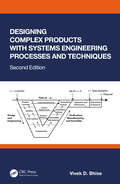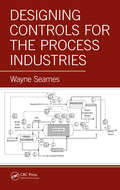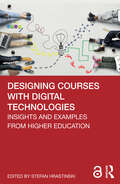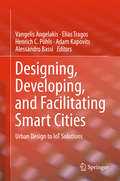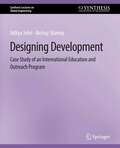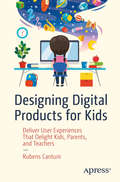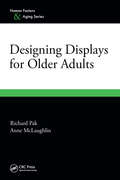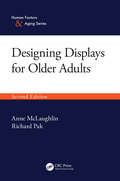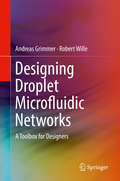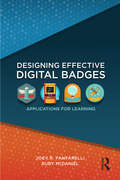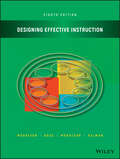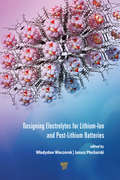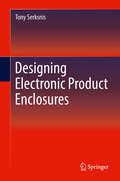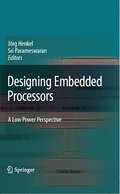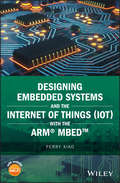- Table View
- List View
Designing Complex Products with Systems Engineering Processes and Techniques
by Vivek D. BhiseCompletely revised including six new chapters, this new edition presents a more comprehensive knowledge of issues facing developers of complex products and process management. It includes more tools for implementing a Systems Engineering approach to minimize the risks of delays and cost overruns and helps create the right product for its customers. Designing Complex Products with Systems Engineering Processes and Techniques, Second Edition highlights how to increase customer satisfaction, quality, safety, and usability to meet program timings and budgets using a Systems Engineering approach. It provides decision-making considerations and models for creating sustainable product design and describes many techniques and tools used in product development and the product life-cycle orientation. The book also offers techniques used in Design for Manufacturing, Design for Assembly, and product evaluation methods for verification and validation testing. Many new examples, case studies, six new chapters, and updated program and data charts held on our website are offered. The book targets practicing engineers, engineering management personnel, product designers, product planners, product and program managers in all industrialized and developing countries. In addition the book is also useful to undergraduate, graduate students, and faculty in engineering, product design, and product project and program management.
Designing Complex Products with Systems Engineering Processes and Techniques
by Vivek D. BhiseCompletely revised including six new chapters, this new edition presents a more comprehensive knowledge of issues facing developers of complex products and process management. It includes more tools for implementing a Systems Engineering approach to minimize the risks of delays and cost overruns and helps create the right product for its customers. Designing Complex Products with Systems Engineering Processes and Techniques, Second Edition highlights how to increase customer satisfaction, quality, safety, and usability to meet program timings and budgets using a Systems Engineering approach. It provides decision-making considerations and models for creating sustainable product design and describes many techniques and tools used in product development and the product life-cycle orientation. The book also offers techniques used in Design for Manufacturing, Design for Assembly, and product evaluation methods for verification and validation testing. Many new examples, case studies, six new chapters, and updated program and data charts held on our website are offered. The book targets practicing engineers, engineering management personnel, product designers, product planners, product and program managers in all industrialized and developing countries. In addition the book is also useful to undergraduate, graduate students, and faculty in engineering, product design, and product project and program management.
Designing Complex Systems: Foundations of Design in the Functional Domain (Complex and Enterprise Systems Engineering)
by Erik W. AslaksenWithout standardized construction elements such as nuts, bolts, bearings, beams, resistors and the like, the design of physical equipment is hopelessly inefficient, and engineers are continually bogged down with re-designing these elements over and over again. Emphasizing a top-down approach, this volume considers the purpose and basic features of design and how the concept of value can provide a quantitative measure of that wider interaction of the engineered object with its environment. This work also develops the domain in which functional design takes place and explores how the system concept can be embedded in that domain. It proposes a number of functional design elements and develops them in considerable detail, outlining how they can be applied as part of a coherent design framework. For greater understanding of the discussed concepts, numerous examples and analogies are included.
Designing Complex Systems: Foundations of Design in the Functional Domain (Complex and Enterprise Systems Engineering)
by Erik W. AslaksenWithout standardized construction elements such as nuts, bolts, bearings, beams, resistors and the like, the design of physical equipment is hopelessly inefficient, and engineers are continually bogged down with re-designing these elements over and over again. Emphasizing a top-down approach, this volume considers the purpose and basic features of design and how the concept of value can provide a quantitative measure of that wider interaction of the engineered object with its environment. This work also develops the domain in which functional design takes place and explores how the system concept can be embedded in that domain. It proposes a number of functional design elements and develops them in considerable detail, outlining how they can be applied as part of a coherent design framework. For greater understanding of the discussed concepts, numerous examples and analogies are included.
Designing Controls for the Process Industries
by Wayne SeamesOffering a modern, process-oriented approach emphasizing process control scheme development instead of extended coverage of LaPlace space descriptions of process dynamics, this text focuses on aspects that are most important for process engineering in the 21st century. Instead of starting with the controller, the book starts with the process and moves on to how basic regulatory control schemes can be designed to achieve the process’ objectives while maintaining stable operations. In addition to continuous control concepts, process and control system dynamics are embedded into the text with each new concept presented. The book also includes sections on batch and semi-batch processes and safety automation within each concept area. It discusses the four most common process control loops—feedback, feedforward, ratio, and cascade—and discusses application of these techniques for process control schemes for the most common types of unit operations. It also discusses more advanced and less commonly used regulatory control options such as override, allocation, and split range controllers, includes an introduction to higher level automation functions, and provides guidance for ways to increase the overall safety, stability, and efficiency for many process applications. It introduces the theory behind the most common types of controllers used in the process industries and also provides various additional plant automation-related subjects.
Designing Controls for the Process Industries
by Wayne SeamesOffering a modern, process-oriented approach emphasizing process control scheme development instead of extended coverage of LaPlace space descriptions of process dynamics, this text focuses on aspects that are most important for process engineering in the 21st century. Instead of starting with the controller, the book starts with the process and moves on to how basic regulatory control schemes can be designed to achieve the process’ objectives while maintaining stable operations. In addition to continuous control concepts, process and control system dynamics are embedded into the text with each new concept presented. The book also includes sections on batch and semi-batch processes and safety automation within each concept area. It discusses the four most common process control loops—feedback, feedforward, ratio, and cascade—and discusses application of these techniques for process control schemes for the most common types of unit operations. It also discusses more advanced and less commonly used regulatory control options such as override, allocation, and split range controllers, includes an introduction to higher level automation functions, and provides guidance for ways to increase the overall safety, stability, and efficiency for many process applications. It introduces the theory behind the most common types of controllers used in the process industries and also provides various additional plant automation-related subjects.
Designing Controls for the Process Industries
by Wayne SeamesOffering a modern, process-oriented approach emphasizing process control scheme development instead of extended coverage of LaPlace space descriptions of process dynamics, Designing Controls for the Process Industries focuses on aspects that are most important for contemporary practical process engineering and reflects the industry’s use of digital distributed control-based systems. The second edition now features 60 tutorial videos demonstrating solutions to most of the example problems. Instead of starting with the controller, the book starts with the process and moves on to how basic regulatory control schemes can be designed to achieve the process objectives while maintaining stable operations. In addition to continuous control concepts, process and control system dynamics are embedded into the text with each new concept presented. The book alsoincludes sections on batch and semi-batch processes and safety automation within each concept area. It discusses the four most common control techniques: control loop feedback, feedforward, ratio, and cascade, and discusses application of these techniques for process control schemes for the most common types of unit operations. It also discusses more advanced andless commonly used regulatory control options such as override, allocation, and split range controllers; includes an introduction to higher-level automation functions; and provides guidance for ways to increase the overall safety, stability, and efficiency for many process applications. It introduces the theory behind the most common types of controllers used in the process industries and provides various additional plant automation-related subjects. The new edition also includes new homework problems and examples, including multiple choice questions for flipped classes, information about statistical process control, and a new case study that documents the development of regulatory control schemes for an entire process area. Aimed at chemical engineering students in process control courses, as well as practicing process and control engineers, this textbook offers an alternative to traditional texts and offers a practical, hands-on approach to design of process controls. PowerPoint lecture slides, multiple-choice quiz questions for each chapter, and a solutions manual are available to qualifying instructors. Tutorial-style videos for most of the text examples are available for all readers to download.
Designing Controls for the Process Industries
by Wayne SeamesOffering a modern, process-oriented approach emphasizing process control scheme development instead of extended coverage of LaPlace space descriptions of process dynamics, Designing Controls for the Process Industries focuses on aspects that are most important for contemporary practical process engineering and reflects the industry’s use of digital distributed control-based systems. The second edition now features 60 tutorial videos demonstrating solutions to most of the example problems. Instead of starting with the controller, the book starts with the process and moves on to how basic regulatory control schemes can be designed to achieve the process objectives while maintaining stable operations. In addition to continuous control concepts, process and control system dynamics are embedded into the text with each new concept presented. The book alsoincludes sections on batch and semi-batch processes and safety automation within each concept area. It discusses the four most common control techniques: control loop feedback, feedforward, ratio, and cascade, and discusses application of these techniques for process control schemes for the most common types of unit operations. It also discusses more advanced andless commonly used regulatory control options such as override, allocation, and split range controllers; includes an introduction to higher-level automation functions; and provides guidance for ways to increase the overall safety, stability, and efficiency for many process applications. It introduces the theory behind the most common types of controllers used in the process industries and provides various additional plant automation-related subjects. The new edition also includes new homework problems and examples, including multiple choice questions for flipped classes, information about statistical process control, and a new case study that documents the development of regulatory control schemes for an entire process area. Aimed at chemical engineering students in process control courses, as well as practicing process and control engineers, this textbook offers an alternative to traditional texts and offers a practical, hands-on approach to design of process controls. PowerPoint lecture slides, multiple-choice quiz questions for each chapter, and a solutions manual are available to qualifying instructors. Tutorial-style videos for most of the text examples are available for all readers to download.
Designing Courses with Digital Technologies: Insights and Examples from Higher Education
by Stefan HrastinskiDesigning Courses with Digital Technologies offers guidance for higher education instructors integrating digital technologies into their teaching, assessment and overall support of students. Written by and for instructors from a variety of disciplines, this book presents evaluations that the contributors have implemented in real-life courses, spanning blended and distance learning, flipped classrooms, collaborative technologies, video-supported learning and beyond. Chapter authors contextualize their approaches beyond simple how-tos, exploring both the research foundations and professional experiences that have informed their use of digital tools while reflecting on their successes, challenges and ideas for future development.
Designing Courses with Digital Technologies: Insights and Examples from Higher Education
by Stefan HrastinskiDesigning Courses with Digital Technologies offers guidance for higher education instructors integrating digital technologies into their teaching, assessment and overall support of students. Written by and for instructors from a variety of disciplines, this book presents evaluations that the contributors have implemented in real-life courses, spanning blended and distance learning, flipped classrooms, collaborative technologies, video-supported learning and beyond. Chapter authors contextualize their approaches beyond simple how-tos, exploring both the research foundations and professional experiences that have informed their use of digital tools while reflecting on their successes, challenges and ideas for future development.
Designing, Developing, and Facilitating Smart Cities: Urban Design to IoT Solutions
by Vangelis Angelakis Elias Tragos Henrich C. Pöhls Adam Kapovits Alessandro BassiThis book discusses how smart cities strive to deploy and interconnect infrastructures and services to guarantee that authorities and citizens have access to reliable and global customized services. The book addresses the wide range of topics present in the design, development and running of smart cities, ranging from big data management, Internet of Things, and sustainable urban planning. The authors cover - from concept to practice – both the technical aspects of smart cities enabled primarily by the Internet of Things and the socio-economic motivations and impacts of smart city development. The reader will find smart city deployment motivations, technological enablers and solutions, as well as state of the art cases of smart city implementations and services.· Provides a single compendium of the technological, political, and social aspects of smart cities;· Discusses how the successful deployment of smart Cities requires a unified infrastructure to support the diverse set of applications that can be used towards urban development;· Addresses design, development and running of smart cities, including big data management and Internet of Things applications.
Designing Development: Case Study of an International Education and Outreach Program (Synthesis Lectures on Global Engineering)
by Aditya Johri Akshay SharmaThe creation of physical and material infrastructure is the cornerstone of human development; not surprisingly, engineers and designers are often motivated and inspired in their practice to improve the world around them, to make things better for others, and to apply their knowledge for the good of mankind. These aspirations often get translated into engineering and design curricula where students and faculty work on development related projects usually under the category of community or service learning. This book presents an overview of such an education and outreach program designed to empower stakeholders to improve their lives. The project described here was an international multi-institutional undertaking that included academic institutions, non-governmental organizations, and private firms. Within the academic setting, an interdisciplinary set of actors that included engineering and industrial design students and faculty worked on the project. We concretize our work by presenting a design case study that illustrates how different approaches can help guide the works of engineers and designers as they create global infrastructures and localized artifacts. We emphasize the importance of developing long term relationships with organizations on the ground in order to ensure appropriate design as well as successful transfer and long term use of designed artifacts. We discuss the life trajectories of the authors to provide a grounded perspective on what motivated us to undertake this work and shaped our approach with the intention to demonstrate that there are multiple paths toward this goal. Table of Contents: Introduction / Development of the Program: Personal Trajectories Meet Professional Opportunities / Intellectual Positioning of the Program: Sociomaterial Infrastructures and Capable and Convivial Design / Case Study: Quick Response (QR) Code Based Immunization Solution / Design for Development Course and Outreach Initiative / Conclusion: Lessons Learned
Designing Digital Products for Kids: Deliver User Experiences That Delight Kids, Parents, and Teachers
by Rubens CantuniChildhood learning is now more screen-based than ever before, and app developers are flocking in droves to this lucrative and exciting market. The younger generation deserves the best, and growing up in a digital world has made them discerning and demanding customers. Creating a valuable user experience for a child is as complex and involved as when designing a typical app for an adult, if not more, and Designing Digital Products for Kids is here to be your guide. Author and designer Rubens Cantuni recognizes the societal importance of a high-quality and ethical app experience for children. There is room for significant improvement in this space, and Cantuni helps you optimize it. Designing Digital Products for Kids walks hopeful developers through digital product design—including research, concept, design, release, marketing, testing, analyzing, and iterating—all while aiming to build specifically for children. Industry experts and their real-world advice are showcased in this book, along with careful advice for the ethics that go along with this unique market. These tips include complex needs regarding mental development, accessibility, conscious screen time limits, and content sensitivity. Children, parents, and teachers alike are hungry for more thoughtful players in the kids’ app space, and Designing Digital Products for Kids is your ticket to successfully developing and educating for the future. What You Will LearnDesign platforms specifically for children, to entertain and educate themWork with a complex audience of parents, teachers and kidsUnderstand how different monetization strategies work in this industry and why Who This Book Is ForUser experience designers, UI designers, product owners, teachers and educators, startup founders. The range of topics is so wide that anyone interested or involved in digital products could find something interesting to learn.
Designing Displays for Older Adults
by Richard Pak Anne McLaughlinLiterally hundreds of papers have been written about interface issues experienced by older adults, but how many actually influence the designs older adults use? The sheer number of articles available, the fast pace of the industry, and time constraints combine to build barriers to knowledge transfer from theory into practice. A distillation of deca
Designing Displays for Older Adults, Second Edition
by Richard Pak Anne McLaughlinThis book focuses on the design of displays and user interfaces for the older user. Aging is related to complex mental, physical, and social changes. While conventional wisdom says getting older leads to a decline, the reality is that some capabilities decline with age while others remain stable or increase. This book distills decades of aging research into practical advice on the design of displays. Technology has changed dramatically since the publication of the first edition. This new edition covers cutting-edge technology design such as ubiquitous touchscreens, smart speakers, and augmented reality interfaces, among others.
Designing Displays for Older Adults, Second Edition
by Richard Pak Anne McLaughlinThis book focuses on the design of displays and user interfaces for the older user. Aging is related to complex mental, physical, and social changes. While conventional wisdom says getting older leads to a decline, the reality is that some capabilities decline with age while others remain stable or increase. This book distills decades of aging research into practical advice on the design of displays. Technology has changed dramatically since the publication of the first edition. This new edition covers cutting-edge technology design such as ubiquitous touchscreens, smart speakers, and augmented reality interfaces, among others.
Designing Droplet Microfluidic Networks: A Toolbox for Designers
by Andreas Grimmer Robert WilleThis book describes automatic methods for the design of droplet microfluidic networks. The authors discuss simulation and design methods which support the design process of droplet microfluidics in general, as well as design methods for a dedicated droplet routing mechanism, namely passive droplet routing. The methods discussed allow for simulating a microfluidic design on a high-abstraction level, which facilitates early validation of whether a design works as intended, automatically dimensioning a microfluidic design, so that constraints like flow conditions are satisfied, and automatically generating meander designs for the respective needs and fabrication settings. Dedicated methods for passive droplet routing are discussed and allow for designing application-specific architectures for a given set of experiments, as well as generating droplet sequences realizing the respective experiments. Together, these methods provide a comprehensive “toolbox" for designers working on droplet microfluidic networks in general and an integrated design flow for the passive droplet routing mechanism in particular.Provides both a comprehensive “toolbox" for designers working on droplet microfluidic networks in general and an integrated design flow for the passive droplet routing mechanism in particular;Describes for the first time CAD methods for droplet microfluidic networks, along with the first integrated design process;Includes open source implementations, in order to reach the largest possible user group within the domain of microfluidics.
Designing Effective Digital Badges: Applications for Learning
by Joey R. Fanfarelli Rudy McDanielDesigning Effective Digital Badges is a hands-on guide to the principles, implementation, and assessment of digital badging systems. Informed by the fundamental concepts and research-based characteristics of effective badge design, this book uses real-world examples to convey the advantages and challenges of badging and showcase its application across a variety of contexts. Professionals in education, game development, mobile app development, and beyond will find strategies for practices such as credentialing, goal-setting, and motivation of their students.
Designing Effective Digital Badges: Applications for Learning
by Joey R. Fanfarelli Rudy McDanielDesigning Effective Digital Badges is a hands-on guide to the principles, implementation, and assessment of digital badging systems. Informed by the fundamental concepts and research-based characteristics of effective badge design, this book uses real-world examples to convey the advantages and challenges of badging and showcase its application across a variety of contexts. Professionals in education, game development, mobile app development, and beyond will find strategies for practices such as credentialing, goal-setting, and motivation of their students.
Designing Electrolytes for Lithium-Ion and Post-Lithium Batteries
by W 322 Adys 322 Aw Wieczorek Janusz P 322 OcharskiEvery electrochemical source of electric current is composed of two electrodes with an electrolyte in between. Since storage capacity depends predominantly on the composition and design of the electrodes, most research and development efforts have been focused on them. Considerably less attention has been paid to the electrolyte, a battery’s basic component. This book fills this gap and shines more light on the role of electrolytes in modern batteries. Today, limitations in lithium-ion batteries result from non-optimal properties of commercial electrolytes as well as scientific and engineering challenges related to novel electrolytes for improved lithium-ion as well as future post-lithium batteries.
Designing Electrolytes for Lithium-Ion and Post-Lithium Batteries
by Władysław Wieczorek; Janusz PłocharskiEvery electrochemical source of electric current is composed of two electrodes with an electrolyte in between. Since storage capacity depends predominantly on the composition and design of the electrodes, most research and development efforts have been focused on them. Considerably less attention has been paid to the electrolyte, a battery’s basic component. This book fills this gap and shines more light on the role of electrolytes in modern batteries. Today, limitations in lithium-ion batteries result from non-optimal properties of commercial electrolytes as well as scientific and engineering challenges related to novel electrolytes for improved lithium-ion as well as future post-lithium batteries.
Designing Electronic Product Enclosures
by Tony SerksnisThis book explains the design and fabrication of any electronic enclosure that contains a printed circuit board, from original design through materials selection, building and testing, and ongoing design improvement. It presents a thorough and lucid treatment of material physical properties, engineering, and compliance considerations such that readers will understand concerns that exist with a design (structural, environmental, and regulatory) and what is needed to successfully enter the marketplace. To this end, a main thrust of this volume is on the “commercialization” of electronic products when an enclosure is needed. The book targets the broadest audience tasked with design and manufacture of an enclosure for an electronic product, from mechanical/industrial engineers to designers and technicians. Compiling a wealth of information on relevant physical phenomena (strength of materials, shock and vibration, heat transfer), the book stands as a ready reference on how and where these key properties may be considered in the design of most electronic enclosures.
Designing Embedded Processors: A Low Power Perspective
by Jörg Henkel Sri ParameswaranTo the hard-pressed systems designer this book will come as a godsend. It is a hands-on guide to the many ways in which processor-based systems are designed to allow low power devices. Covering a huge range of topics, and co-authored by some of the field’s top practitioners, the book provides a good starting point for engineers in the area, and to research students embarking upon work on embedded systems and architectures.
Designing Embedded Systems and the Internet of Things (IoT) with the ARM mbed
by Perry XiaoA comprehensive and accessible introduction to the development of embedded systems and Internet of Things devices using ARM mbed Designing Embedded Systems and the Internet of Things (IoT) with the ARM mbed offers an accessible guide to the development of ARM mbed and includes a range of topics on the subject from the basic to the advanced. ARM mbed is a platform and operating system based on 32-bit ARM Cortex-M microcontrollers. This important resource puts the focus on ARM mbed NXP LPC1768 and FRDM-K64F evaluation boards. NXP LPC1768 has powerful features such as a fast microcontroller, various digital and analog I/Os, various serial communication interfaces and a very easy to use Web based compiler. It is one of the most popular kits that are used to study and create projects. FRDM-K64F is relatively new and largely compatible with NXP LPC1768 but with even more powerful features. This approachable text is an ideal guide that is divided into four sections; Getting Started with the ARM mbed, Covering the Basics, Advanced Topics and Case Studies. This getting started guide: Offers a clear introduction to the topic Contains a wealth of original and illustrative case studies Includes a practical guide to the development of projects with the ARM mbed platform Presents timely coverage of how to develop IoT applications Designing Embedded Systems and the Internet of Things (IoT) with the ARM mbed offers students and R&D engineers a resource for understanding the ARM mbed NXP LPC1768 evaluation board.
